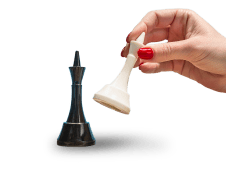
The Beginner’s Guide to SEO

December 5, 2022
Cecilia
If you’re seeking to revamp your marketing strategy for 2023, chances are you’ve already looked into SEO services. After all, SEO is one of the fundamental drivers of an excellent digital marketing strategy; it’s the golden ticket to being discovered organically by your online audience.
Sounds a little too good to be true, right? Well, there is a catch.
SEO is technical, which can make it difficult to learn and continually master. But we certainly wouldn’t recommend missing out on this crucial part of your marketing plan. It’s well worth the effort to buckle down and understand the basics, even if you are outsourcing SEO services to an external marketing team.
In this guide, we’ll show you what SEO is, why it matters and how to create a killer SEO marketing strategy.
What Is SEO?
SEO stands for search engine optimization. Companies use SEO to boost their visibility in organic search results. By ranking high on the list of search query results, companies have a better chance of garnering website traffic and conversions.
How Does SEO Work?
Even if you’re outsourcing your SEO services, it’s good to know some of the key terms that you might hear while digging into the technical side of things.
Essentially, SEO works by analyzing your website based on a variety of factors (such as load time, keyword density and the quality of backlinks) and then ranking it in the search engine results page, or SERP.
What does that process look like? Search engines like Google and Bing send out little bots to crawl pages on the web. Those bots find and index the information on those pages, analyzing hundreds of ranking factors to determine which pages come up first in a search query.
Picture the web like a giant library full of books. The bots are the librarians and know what’s in each book. That enables them to point you to the exact title that will answer your question at record speed.
Unlike paid search campaigns, you can’t pay a search engine to rank your content any higher. It’s an organic strategy that takes continuing massaging and maintenance to get right.
Google and other search engines constantly update their parameters for ranking content. They never actually publish their ranking factors, though, which can make SEO feel a little like you’re flying blind.
However, the three fundamental branches of SEO always remain the same, so you can always return to these core tenets if you feel lost. These branches will make up the core of your SEO strategy, so it’s important to be familiar with them before building out that strategy.
The three branches are technical optimization, on-page optimization and off-page optimization.
- Technical optimization: Think of technical optimization as taking care of your behind-the-scenes SEO. It refers to bolstering parts of your website that aren’t related to content to improve SEO. For example, search engines index your page depending on its load speed. Faster websites are ranked higher because they offer users a better experience. Enhancing your website’s load time is one way to work on your technical optimization.
- On-page optimization: On-page optimization refers to ensuring your content is relevant and provides a great user experience to your human readers. (SEO isn’t just about catering to bots!) That can include improving meta titles, using the right keywords and putting eye-catching visuals on the page.
- Off-page optimization: Believe it or not, what goes on outside of your site can impact its search engine rankings. Off-page optimization means enhancing your site’s rankings through activities that occur beyond it. A good example of this is by getting backlinks (in other words, getting high-value pages to link to your site).
We know what SEO is and the fundamentals of how it works. Now, let’s get into the details of why SEO is an important part of your marketing strategy.
Why Does SEO Matter?
60% of respondents to a recent Statista survey said they do at least some kind of online research before buying from a company. Moreover, the lion’s share of clicks on search results is on organic posts–not on paid ads.
A strong online presence requires strong SEO. Your potential customers are inundated with information from your competitors. You want your website to be front and center when your customers type a query into their search engines. And you want to ensure you’re offering relevant, insightful information to keep them coming back.
Ready to create an SEO strategy? Here’s what you need to know.
How Can I Build An SEO Marketing Strategy?
- Begin by setting your SEO goals.
Before jumping into any grand endeavor (and SEO certainly counts as one), ask yourself: what’s the end goal? What are you hoping to achieve with the actions you take?Maybe it’s to drive more traffic to your e-commerce site. Or perhaps you’re looking to increase conversions through lead generation. No matter what your goals, quantify them and set a target date. Work backwards from there. - You’ll then go ahead with the technical optimization.
Your website needs to be set up to allow search engine bots can crawl and index the pages. Bots can only read text. So, even if your website is well-designed and looks good to you, it’s possible that bots won’t be able to read it.Make sure your navigation and links are text-only. Keep URLs in links short (bots, like people, don’t like reading long strings of text). Put your primary keyword in the page’s URL if possible.Next, get an idea of your website’s current speed. You can use Google’s PageSpeed Insights tool to do this. Lots of factors contribute to load speed, like image size and browser caching.
Make sure all your links are working. Search engines can’t index dead or broken links.
Finally, create a sitemap and robots.txt files. A sitemap lists all the URLs on your website in one file. It tells bots what to crawl and index. On the other hand, a robots.txt file tells bots what not to index.
- Now, it’s time to enhance your content with on-page optimization.
When we say “content,” we’re referring to anything you’d find on a web page that’s answering your questions–whether that’s a blog post, a video or an infographic.Content is exactly what potential customers are looking for when they’re typing a query into Google. That means you should be offering high-quality, relevant content on your website to attract and engage them. And by creating high-quality content with relevant keywords, you’ll make it easier for bots to crawl and index your site to offer up to your audience.Conducting keyword research plays a big role in optimizing website content. You’ll start by identifying general terms, themes and topics relevant to your business. Then, you’ll need to narrow those down into keywords. Finally, you’ll conduct some research to discover which terms your audience is plugging into a search engine.
These keywords will inform the sections and pages on your website, as well as your content marketing SEO strategy, which we’ll dive into shortly.
- Next, bring off-page optimization into the picture.
Here’s where link building comes into play. Link building refers to the process of acquiring backlinks. This can be done in a few ways.First, you can email other websites to tell them about a great piece of content you’ve just published, and why their readers might benefit from it. You might even suggest where that link could go on their website.You can also reach out to websites and publications to write a guest post that links back to your website.
Or, you can analyze your competitors’ backlinks and see which ones you might be able to recreate.
- Monitor and track your results, then adjust your strategy as needed.
SEO key performance indicators (KPIs) will also vary depending on the goals you set. However, lots of companies measure the value of their SEO efforts by looking at the following:- Organic traffic growth
- Conversions from organic traffic
- The top pages attracting traffic
- Number of indexed pages
Building A Content Marketing SEO Strategy
As you’ve probably guessed by now, content marketing and SEO go hand in hand. That’s because any content you put on your website is prime real estate for optimization. The more your content marketing strategy aligns with your SEO, the better.
High-quality content has always been, and continues to be, a top ranking factor for search engines. For most websites, blogs are the engine behind that content. Here’s a high-level, step-by-step guide for building a robust content market SEO strategy.
- Make a list of topics relevant to your business or audience.
- Make a list of long-tail keywords based on these topics.
- Build out pages for each topic.
- Create your blog, and follow the pillar-cluster content model.
That model involves creating “pillar” content (i.e. longer-form content that informs readers on a high level), then linking to “cluster” content within (shorter pieces that go in depth in a particular keyword or subject).For example, let’s say are you an e-commerce brand that sells little rubber boots made for ducks. Your pillar piece might answer the question, “Why should all ducks be wearing little rubber boots?” In the article, you might link to smaller pieces of related content, such as the article, “The top 10 colors for duck rubber boots this fall.” - Create a consistent blogging schedule.
- Figure out how you’re going to win your backlinks.
- Check the size of your media pieces before uploading them.
Don’t slow down your site with big images and videos! - Monitor and measure your content’s performance.
Rinse and repeat.
Last Words
SEO is an ever-evolving beast. This guide certainly isn’t exhaustive, but it should give you a high-level overview of some of the basics, why it’s leveraged and how to get your own SEO wheels turning.
Still, SEO is understandably daunting. It happens to be our bread and butter, but that doesn’t mean it has to be yours. In need of expert SEO services? Get in touch! Our team of technical SEO experts is here for you.

























